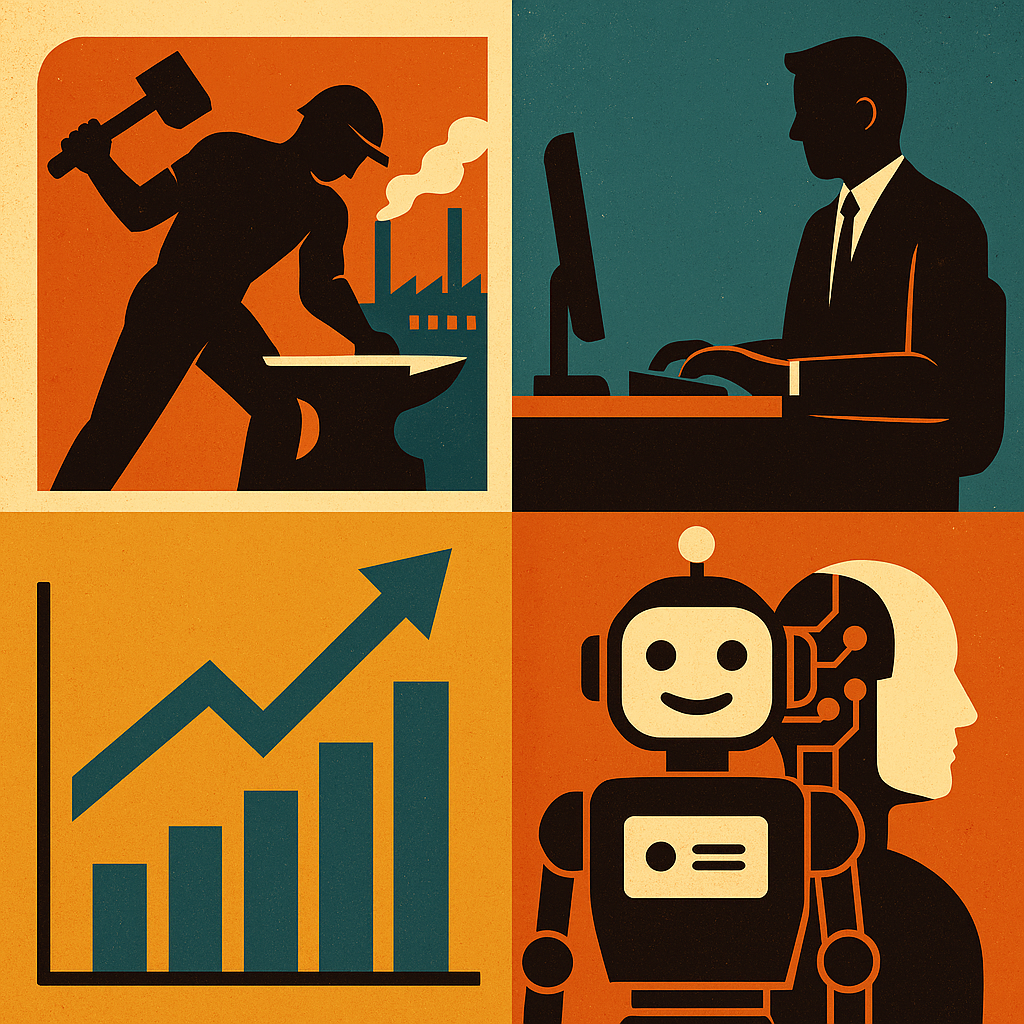
ChatGPT:
📉📈
Humans vs. Machines: A (Mostly) Friendly Struggle for Employment
A Bullet-Point History of Work, Worry, and Why You Should Still Learn Plumbing
🏛️ Once Upon a Time: The Industrial Revolution and Its Dirty Little Steam-Powered Secrets
- In the 18th and 19th centuries, the Industrial Revolution dragged us out of the fields and into the factories.
- Machines began replacing biceps with levers, sparking fears of mass job loss. (Spoiler: they weren’t entirely wrong — but also not entirely right.)
- The Luddites famously smashed weaving machines in protest, proving once again that people hate change unless it’s in their couch cushions.
Bottom line: Yes, machines replaced jobs — but they also created new ones. Hello, factory supervisors. Goodbye, sheep-shearers.
🏭 Then Factories Got Fancy: Enter the 20th Century
- Technological progress continued, but instead of just replacing muscle work, it started automating repetitive tasks in manufacturing.
- Assembly lines and early automation made productivity soar and reduced the need for humans to do boring stuff like tighten bolts all day.
- But people found new work: driving trucks, running offices, filling out forms, yelling at interns.
Lesson here? Humans moved up the food chain — from doing the work to organizing it, managing it, or talking about it on conference calls that should’ve been emails.
🧠 The Knowledge Economy: Computers Giveth, and Also Taketh Away
- Starting in the 1970s–1980s, computers rolled into workplaces like glitter at a toddler’s birthday — spreading everywhere and refusing to leave.
- This kicked off what economists call Skill-Biased Technological Change (SBTC):
- Technology made skilled workers more productive (and rich-ish).
- Less-skilled workers? Not so much.
- Office workers who knew how to use Excel were suddenly indispensable. Workers who didn’t? Suddenly dispensable.
Translation: Computers didn’t destroy all jobs — they reallocated opportunity based on who could speak “Microsoft Office” fluently.
🤖 Enter AI: The Robot With a LinkedIn Account
- Today’s AI is not your grandma’s machine. It’s not just replacing muscle or memory — it’s gunning for middle-class brain work too.
- AI systems (like me, hi) now handle:
- Writing emails,
- Analyzing data,
- Diagnosing illnesses,
- Creating art,
- And sometimes pretending to be better at poetry than they actually are.
Big vibe shift: This isn’t just “skill-biased” anymore. It’s task-biased — if your job includes repetitive, predictable tasks, AI wants it. Regardless of whether you wear a hard hat or a tweed blazer.
💼 But Wait, There’s History! And Hope. (Sort Of.)
- Let’s rewind to some very smart (and very nervous) economists:
- John Maynard Keynes warned about “technological unemployment” back in the 1930s — fearing machines would replace workers faster than we could invent new jobs.
- In the 1980s, Wassily Leontief said, “What the combustion engine did to horses, AI will do to us.”
- Horses never made a comeback. They got replaced. Fully. 100%. Sad horse emoji.
- But unlike horses, humans are sneaky. They adapt. They learn new tasks. They invent jobs like:
- Social media manager,
- TikTok influencer,
- AI prompt engineer (a fancy way to say “person who tells the robot what to do”).
Point being: So far, humans have survived every wave of tech, mostly by moving sideways into tasks that haven’t been automated… yet.
🧩 AI and the Modern Worker: Who’s Safe, Who’s Sweating?
- AI is eating the middle of the labor market:
- Entry-level white collar jobs? Under threat.
- Legal research, data crunching, even basic code-writing? Totally GPT-able.
- But guess who’s doing fine?
- Plumbers, electricians, caregivers, therapists, teachers — jobs that are physically, emotionally, or contextually complex.
- Creative professionals with taste and judgment — because AI can generate content, but it can’t decide what’s cool (yet).
- People who know how to use AI well — not just build it, but guide it, prompt it, and translate its outputs into human usefulness.
New motto: If you can’t beat AI, learn to boss it around.
🛠️ So What Should You Learn Now, Instead of Crying Into Your Resume?
🚫 Jobs AI Can’t Easily Do:
- Therapy (talking to a robot about your childhood is not ideal).
- Teaching and mentoring.
- Skilled trades (robots still suck at drywall).
- Complex decision-making involving real humans.
- Taste-making, judgment, vibes, leadership. (Yes, “vibes” are an economic advantage now.)
✅ Jobs That Use AI to Look Way Smarter Than You Are:
- Prompt engineer (actual job title now).
- Automation consultant (aka “person who Googled how to use Zapier”).
- Creative director using AI tools for fast output.
- Analyst who uses AI to produce 10x more charts than a normal human.
📚 Final Thoughts: From Pies to ATMs to Radiologists
- Economists talk about the “changing pie” — not just that the economy grows, but that what’s in it changes.
- 300 years ago: farms.
- 200 years ago: factories.
- Today: offices, platforms, gig work, vibe-checking content calendars.
- AI might shrink some slices, but it’ll bake new ones:
- Jobs we haven’t imagined yet.
- Tasks that emerge from new industries.
- Work centered on being human in ways machines can’t (or at least, shouldn’t).
In the war between technology and jobs, humans haven’t lost — they’ve just had to reinvent themselves repeatedly. And now, in the age of AI? Time to reinvent again. Preferably before your chatbot boss schedules your next Zoom meeting.
💌 TL;DR for the Skimmers:
- AI is real. It’s powerful. It’s here to mess with your job.
- Don’t panic. History suggests we adapt.
- Learn to do what AI can’t (emotion, judgment, context).
- Or use AI so well that no one notices you’ve been working 3 hours a week.
And if all else fails?
Become a plumber. Seriously. They’re recession-proof and robot-proof.
